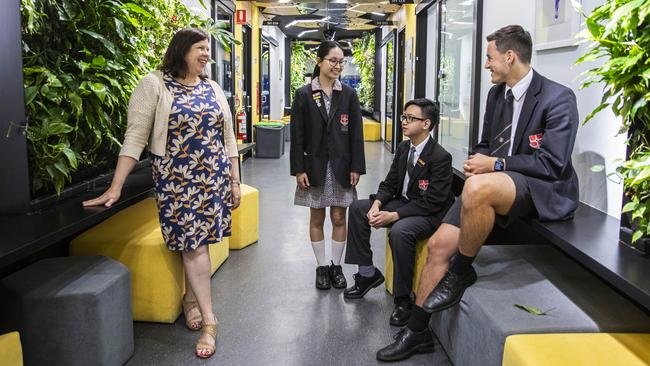Fears for pupils who logged off
Schools are battling to get students back to class in the wake of the pandemic and are having to wait six months to get support for teenagers who disengaged from learning.

Thousands of Victorian students stopped attending class or completing school work by the end of Victoria’s extended lockdown, sparking fears many could drop out of education for good.
Demand for services to support disengaged teenagers has surged in the wake of the pandemic, with the waiting list for the Andrews government’s multi-million-dollar Navigator program, which supports students at risk of not completing schooling, blowing out to six months.
Many schools are grappling with having to contact dozens of students who dropped off the radar as remote learning stretched to more than 20 weeks for some.
“We are trying to follow up 53 kids who we lost during remote learning,” said a principal of a large regional secondary college.
“Chronic under-attendance is a wicked problem; the Navigator program will be swamped.”
Concerns that large numbers of young people will not return to school at all — and the resultant social ramifications — has prompted calls to embed more social workers into schools.
Melbourne social worker Les Twentyman is worried about the impact of the lockdown on young people, saying it is still too early to understand the impact on this generation of students.
“It won’t be seen for some time, which is why we need to act now and get youth support workers into schools,” he said.
“I’ve always said ‘Keep kids in classrooms and out of courtrooms’. Keeping kids engaged in school is crucially important.”
Victorian education officials have conceded that the decision to close schools for most of term two and all of term three has had an impact on student engagement.
Schools were required to record attendance during remote learning. According to a Department of Education report into the lessons from the remote learning experiment, student attendance statewide during term two was, on average, better than the previous year (but) it dropped across “secondary schools, in low socio-economic areas, and in rural and regional areas”, the report said.
Attendance data for term three has not been publicly released.
The department said there was strong demand for the Navigator service but declined to say how many students had been referred and how long they’d wait until being allocated a case worker.
A department spokeswoman said the government’s recent $28.5m investment in mental health and student engagement support would increase capacity of the Navigator Program by one-third, enabling more than 2000 extra at-risk youth get support.
“Demand for Navigator services is high and (it) seeks to support as many young people as possible, while prioritising the most vulnerable young people,” she said. “Schools make every effort to re-engage students before they’re referred to Navigator.”
Piloted in 2016, Navigator provides intensive support for students whose attendance has dipped below 30 per cent. The education department’s latest annual report says it has a success rate of 63 per cent.
Drouin Secondary College senior team leader Jessica Dunn said the waiting list in the inner- Gippsland region was about six months, meaning there was little chance a student referred now would be accepted by the start of the next school year.
Dr Dunn said schools were frequently referred to external agencies, were already stretched, that often recommended strategies already tried. “We have students from before COVID-19 still not picked up or followed up by the program. There is little successful re-engagement of these students.”
Navigator programs run by Anglicare in Melbourne’s west, Barwon and Mallee regions are at capacity and chief executive Paul McDonald is anticipating a rush in referrals of students who dropped off the radar in recent months.
“We’ve had schools report that the longer lockdown went on, more students slipped away,” Mr McDonald said.
“By the end of September [and] into October, there were many more teachers asking ‘Where’s such and such?’ ”
Caroline Chisholm Catholic College in Braybrook in Melbourne’s west serves an ethnically diverse and disadvantaged community; many of its students were impacted by family illness and unemployment during the pandemic, but it has avoided having to rely on programs such as Navigator because of well-established in-house wellbeing supports, including a teacher-student mentor program. “We didn’t really have a lot of issues with student engagement,” said deputy principal Stephanie Banks.
“Our wellbeing team put in a lot of work to keep kids connected. Those who did need greater support, we had them on site.”







To join the conversation, please log in. Don't have an account? Register
Join the conversation, you are commenting as Logout